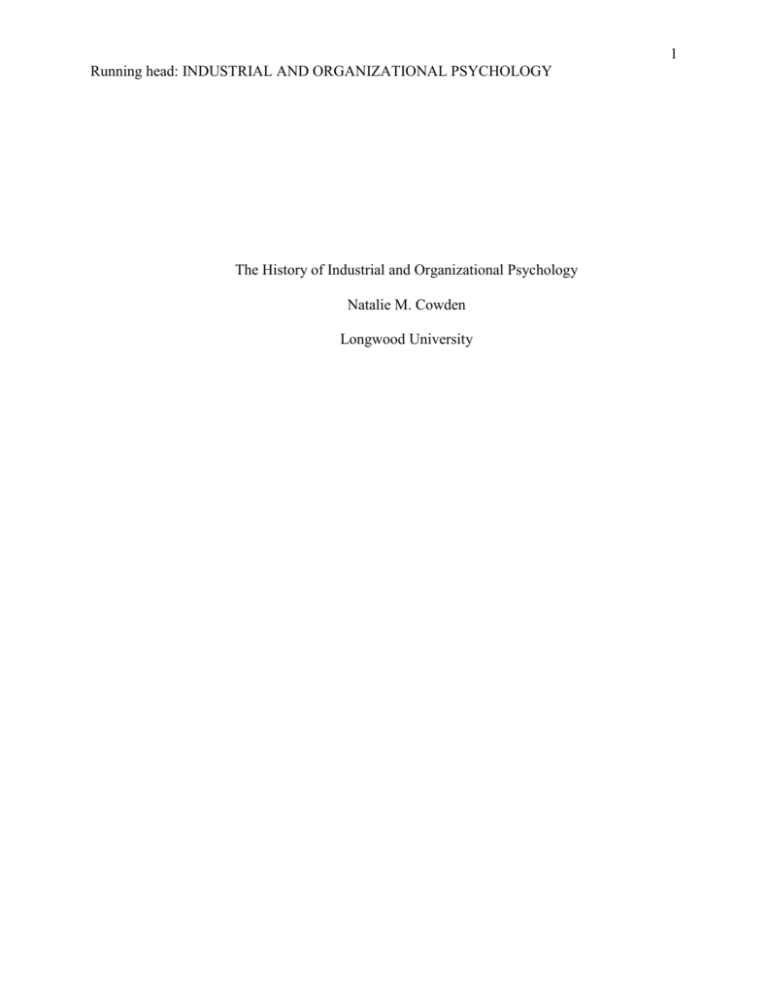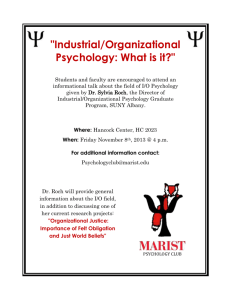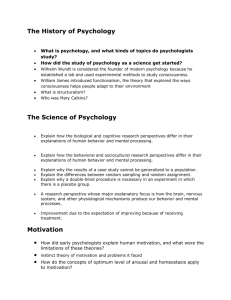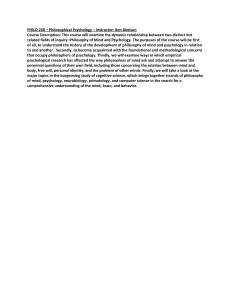Running head: INDUSTRIAL AND ORGANIZATIONAL
advertisement

1 Running head: INDUSTRIAL AND ORGANIZATIONAL PSYCHOLOGY The History of Industrial and Organizational Psychology Natalie M. Cowden Longwood University 2 INDUSTRIAL AND ORGANIZATIONAL PSYCHOLOGY Abstract This paper reviews the past to discover the influential people and factors that contributed to Industrial and Organizational psychology as it is viewed today. Hugo Münsterberg, Walter Dill Scott, and Walter Van Dyke Bingham are all considered to be founding fathers. World War I and World War II also had a profound influence; WWI gave applied psychology the credit it deserved in order to be accepted, while WWII brought continued interest and applied the knowledge learned throughout the war to benefit industries and businesses. The single most effective event, however, may be the Hawthorne studies, which brought about the idea that communication, leadership, structure, and human relations were vital to a productive work force. This paper also examines what is most likely in store for the newly developed division of Industrial and Organizational psychology. Keywords: Industrial and Organizational psychology, Hugo Münsterberg, Walter Dill Scott, Walter Van Dyke Bingham, World War I, World War II, Hawthorne studies 3 INDUSTRIAL AND ORGANIZATIONAL PSYCHOLOGY Industrial and Organizational psychology (otherwise known as I-O psychology) is the application of psychology to business, organizational, and workplace settings. Within this area there are specific domains including hiring, leadership, group dynamics, worker’s wages, evaluation, protection, and diversity (“Society for industrial,” 2012). In simpler terms, this branch deals with actions performed within the work environment and accounts for all factors that increase occupation efficiency and productivity (Koppes & Pickren, 2007). Even though psychology is a rather modern science, industrial and organizational psychology as it is known today is a comparatively younger field. Moreover, I-O psychology is not recognized as fully emerging and growing until the early 20th century (P. Drenth, H. Thierry, P. Willems & C. Wolff (Eds.), 1984). In order to fully understand this, however, one must understand the history of I-O psychology. Even though its origin truly begins in the early 20th century, however, I-O still had a long ways to go; industrial and organizational psychology was not even officially the name of this division until 1970 (Muchinsky, 1987). I-O psychology was referred to by many names over the course of time, including industrial psychology, employment psychology, business psychology, and even economic psychology (Koppes & Pickren, 2007). Early Ideas Although the true history of what is considered to be today’s industrial and organizational psychology began in the early 1900s, ideas of this type of thinking can be found as far back as Plato and the ancient Chinese. In The Republic, Plato suggested a leadership selection and expansion plan. He also set forth a classification of citizens that included three groups: the guardians, auxiliaries, and the workers. For each of these factions he advised ways in which the members could be chosen and trained for positions. Over 3,000 years ago the Chinese also had a selection method for bureaucrats that began with local assessments, carried on to regional 4 INDUSTRIAL AND ORGANIZATIONAL PSYCHOLOGY evaluations, and finally ended in the capital (redo?). These plans never caught on, however, because they were isolated from one another and quickly faded with time. (Katzell & Austin, 1992). Roots of I-O Psychology and the Early 1900’s The early 20th century signifies the start of applied psychology in the United States, as this was a time of industrial and social turmoil. The transcontinental railways suddenly permitted accumulation of wealth, growth of corporations, increased urbanization, mass production, and national trade. America’s new and growing economy brought about new problems that had never before been faced (Zickar & Gibby, 2007). The 20th century was also marked by conflict amongst various schools of thought in psychology, specifically structuralism, psychodynamism, and functionalism. Therefore industrial psychologists that emerged from this period were engaged strictly in experimental psychology and had a background in these schools rather than in industrial psychology (Zickar & Gibby, 2007). It is also essential to realize that the birth of I-O psychology in the United States is unlike its birth in Europe (Vinchur & Koppes, 2007). The development in the United States was during the first half of the 20th century, while Europe (excluding Germany and England) caught up primarily after WWII (P. Drenth, H. Thierry, P. Willems & C. Wolff (Eds.), 1984). There are two primary speculations for what the cause of industrial psychology’s growth in the United States was. One hypothesis was that it is owed to university psychologists who applied this new psychology to business circumstances, yet upheld their connections with universities because of the stigma that came along with applied psychology. A second speculation suggested that the growth of industrial psychology was owed to business men that sought out psychologists in order 5 INDUSTRIAL AND ORGANIZATIONAL PSYCHOLOGY to further their companies’ development and resolve business issues. This is also credible considering business leaned on psychology during this period to boost work efficiency (Koppes & Pickren, 2007). American psychologists tended to also concentrate most heavily on problems of personnel selection and placement, which will be seen when WWI is discussed (Siegel, 1969). Important Figures in the Early 20th Century Before discussing any further events and ideas leading up to the birth of industrial and organizational psychology, it is important to first individually discuss the central figures that made such an impact on this field. I-O psychology recognizes three figures as being its founding fathers, along with many people who played crucial supporting roles to both I-O psychology and psychology in general. The first of the founding fathers, Hugo Münsterberg, was a German psychologist invited by William James to study at Harvard. Münsterberg originally criticized applied psychology, yet soon changed his position and became a well-known front runner in the application of psychology to practical problems of industry. He taught classes in applied psychology and published his first industrial psychology article in McClure’s Magazine that presented possible ways to apply psychology to business situations (Vinchur & Koppes, 2007). Out of this publication arose numerous business opportunities which eventually made way for his most famous book in industrial psychology, Psychology and Industrial Efficiency (1913). This book outlined three essential parts of applying psychology to business: designing work conditions, the methods by which psychology can be used in sales, and choosing workers (Muchinsky, 1987). At the time Münsterberg was busy successfully providing a solid base for future studies concerning selection and training, however, Walter Dill Scott, one of Wundt’s students, had begun to make significant strides for industrial psychology. One of these included his publication 6 INDUSTRIAL AND ORGANIZATIONAL PSYCHOLOGY of Influencing Men in Business in which Scott continued to develop cognitive features of industrial psychology (Stagner, 1982). Upon Münsterberg’s death in 1916, it was clear that Walter Dill Scott had already begun paving the way to becoming the next well known founding father (Landy, 1993). Scott’s true beginning in industrial psychology, however, happened while he was working as a psychology professor at Northwestern University. Scott was approached by Thomas K. Balmer, an advertising manager seeking help. Balmer insisted that Scott give a speech on how psychology could benefit and be useful in advertising. Scott initially refused the offer; Wundt had never trained him in advertising (Landy, 1993). Nevertheless, he eventually agreed and his speech was well received by the audience. Due to the success of the talk, Scott was persuaded to write a string of articles demonstrating the use of psychology in advertising which led to publishing two famous books (Haller Gilmer, 1961). The first book, The Theory of Advertising (1903), concerned ways to persuade people through proposition and argument. The second, The Psychology of Advertising (1908), demonstrated replication, devotion, rivalry, and attentiveness as ways to improve human competence (Muchinsky, 1987). Scott continued writing and by 1915, only seven years later, he had published at least 6 books and over 100 articles (Vinchur & Koppes, 2007). Then in 1916, Scott was assigned to teach at Carnegie Institute of Technology in the Division of Applied Psychology, making Scott the first to teach applied psychology. The Division of Applied Psychology was unknown to Universities and psychologists alike and devoted to applying psychology to business under the supervision ofWalter Van Dyke Bingham (Ferguson, 1961) Walter Van Dyke Bingham, I-O’s third founding father and a very talented psychologist, traveled to Columbia University after earning his degree in 1907 from the University of Chicago. 7 INDUSTRIAL AND ORGANIZATIONAL PSYCHOLOGY At Columbia University he worked alongside Cattell and Thorndike until he was offered a position as the head of Dartmouth’s new psychology laboratory (Landy, 1993). It was here that that he worked in conjunction with Scott then made way to Pittsburgh in 1915 to meet with Arton Hamerschlag and Edward A. Woods. Woods was a well-known businessman at the time and asked for Bingham to arrange for a course in salesmanship at Carnegie Institute of Technology. After agreeing to research this area and obtaining the necessary funds, the Bureau of Salesmanship Research was founded in 1916 headed by Scott. Scott and Bingham then traveled to Detroit to meet Guy Montrose Whipple, a well-known figure in creating mental tests. Together these three men attended the World’s First Salesmanship Congress in which they were the first to demonstrate the flaws and undependability of the employment interview (Ferguson, 1961). Yet Bingham’s input was far greater than just his work at Carnegie Institute of Technology; Bingham also made great strides in both WWI and WWII for psychology and had many significant publications. Because of this, he is considered to be a dominant activist for industrial psychology (Vinchur & Koppes, 2007). Various others proved to be significant to the history of I-O psychology as well. One of these men, Frederick W. Taylor, was not a psychologist but an engineer that obtained various patents over his lifetime. Taylor, who began as an employee at a company and eventually worked his way up to the plot manager, recognized firsthand how essential it was to change the environment in which people currently worked. This would not only benefit the company by helping to produce at maximum efficiency, but also help to increase wages for workers (Muchinsky, 1987). He outlined these ideas in his most famous work, Principles of Scientific Management, which had four main principles. These principles were: 1. scientifically designing work methods for efficiency 2. selecting the best workers and training them in new methods 3. 8 INDUSTRIAL AND ORGANIZATIONAL PSYCHOLOGY developing a cooperative spirit between managers and workers and 4. sharing the responsibility of the design and conduct of work between management and the worker (Muchinsky, 1987). Another name that must be mentioned is James Cattell. Unlike Münsterberg, Cattell had always stressed the importance of applied psychology and developed various rating scales and measurements to determine individual differences which could be applied to the psychology of business. He also founded the Psychological Corporation, which was one of the most prominent organizations devoted to applied psychology. Although his contribution to industrial psychology is not as significant as that of the founding fathers, he still plays a vital, sustaining part (Landy, 1993) World War I (1917-1918) World War I had a momentous impact on the way people viewed applied psychology. Robert M. Yerkes, president of the American Psychological Association at that time, immediately signaled APA’s governing council for an emergency session the day WWI began on April 6, 1917. Over the course of two sessions that took place on April 21 and 22, Yerkes was convinced that psychology could aid the cause and he wished to uncover methods by which psychologists could help contribute to the war. After much deliberation, the majority agreed that the most essential way in which to assist in the war effort was to test army recruits. Scott, however, disagreed; he firmly believed that psychologists should spend their time assisting in the selection of army officers (Ferguson, 1961). Nevertheless, Yerkes continued on the mission and created a screening test to eradicate recruits in poor mental condition, classify those reporting for service based upon their intelligence, and promote those with advanced mental ability to officer status. Then Yerkes, leading A Committee on the Psychological Examination of Recruits, completed two tests. The first was the army Alpha for literates and the second the army Beta for 9 INDUSTRIAL AND ORGANIZATIONAL PSYCHOLOGY illiterates (Ferguson, 1961). Committees of psychologists also formulated tests that examined recruits’ incentives, self-esteem, and obedience (Muchinsky, 1987). Over 3,000 people enlisted for the army completed these, and due to the remarkable outcome the council received support from the government (Ferguson, 1961). Walter Scott refused to give up, however, and continued research of his own as well. He categorized soldiers, rated the capability of the officers to perform their duties, and set up and developed job qualifications for hundreds of jobs (Koppes & Pickren, 2007). Unfortunately, months after Scott and Yerkes began administrating the tests, the war ended and testing ceased as well. Nonetheless, psychologists’ reaction to WWI and the aid they provided finally gave applied psychology the recognition and authority it deserved. There was no longer a stigma attached, and it was noted that psychologists made important and necessary contributions. Due to this, industrial research took a considerable shift in direction after World War I (Muchinsky, 1987). Between the wars After the war, psychologists realized that the testing for the Army could quite possibly be applied to industry as well. As a result, the Committee on Classification of Personnel thought to put together an organization that would offer businesses the equivalent of personnel testing built for the Army. Here marks the start of the Scott Company, which in 1919 became the first personnel consulting firm and worked to establish, systematize, and build a workforce for personnel divisions (Vinchur & Koppes, 2007). By doing this, Scott and his associates realized that the worker and the job were not separate but instead one essential component. They promoted workers and managers to establish sound, positive relations with one another; in other words, they focused mainly on “personnel” psychology (Ferguson, 1961). 10 INDUSTRIAL AND ORGANIZATIONAL PSYCHOLOGY Although the Scott Company closed within a few short years, it remains a significant influence. This influence can be seen throughout the book Personnel Management, published by Scott and Clothier. It continues to set the standard for what we call today personnel administration and practice (Ferguson, 1961). Hawthorne Studies (1924) The Hawthorne experiments, which began in 1924, were the single most noteworthy study in the history of industrial psychology (Muchinsky, 1987). These experiments, performed by Harvard researchers, began at the Western electric company at the Hawthorne plant originally to determine the effects of physical conditions in the workplace on employee productivity. The researchers tested factors such as illumination, temperature, and humidity to determine the effect on the worker’s efficiency. This study began with the intentions of being a one-year project; as the pieces of human problems and productivity began to unravel, however, it became much more involved (Ferguson, 1961). The researchers discovered something they had never expected; there was no correlation between the workers’ productivity and environmental factors such as illumination. Strangely enough, the productivity of these workers seemed to either remain agreeable or enhance despite of the lighting. After further studies and much deliberation on the matter, researchers realized that these outcomes had nothing to do with the physical factors but that the workers wanted to satisfy them. The employees were flattered that their employers took the time and effort to study them and therefore wished to impress them in return (Muchinsky, 1987). All of a sudden, psychologists and researchers recognized humans’ work productivity as much more intricate and complex than originally thought; workers’ emotions and reactions became crucial factors as well (Landy, 1985). These experiments offered various answers to 11 INDUSTRIAL AND ORGANIZATIONAL PSYCHOLOGY issues that are still fundamental and dramatically changed the way people thought about industrial psychology. Issues such as supervision, attitudes, human relations, and social organizations finally became an important part of an efficient workforce, not simply workers’ wages or illumination. Because of the impressive advancements the Hawthorne studies provided, they persisted for 15 years (Siegel, 1969). World War II (1941-1945) When World War II came underway, psychologists were the first called upon to expand selection and training programs. The Army General Classification Test (AGCT) was developed, which still stands as one of the most famous analysis of group testing in history. The AGCT sorted army recruits into groups dependent upon their capacity to learn and a soldiers’ obligation and dependability. Psychologists also utilized stress tests, aptitude tests, trade proficiency tests, as well as techniques for choosing officers. Then in 1943, the military created the Applied Psychological Panel that focused mainly on researching and developing three areas crucial to helping the war effort: training, organization of personnel, and improved equipment design (Muchinsky, 1987). With so many soldiers away at war, it was necessary that a productive work force was maintained back home in order to keep businesses and industries stable. To achieve this, there was a dramatic increase in the use of employment tests, along with a desperate effort to help decrease worker absenteeism. Psychologists soon discovered that the methods employed during WWII could be used after the war was over, as the majority of knowledge gained concerning selection and categorization of the Army and Navy proved pertinent to industrial problems (Muchinsky, 1987). Innovative tests were created, investigation commenced concerning 12 INDUSTRIAL AND ORGANIZATIONAL PSYCHOLOGY assessment issues, and knowledge was gained regarding applying the principles of learning to practical training crisis (Ferguson, 1961). Although the use of wartime knowledge significantly impacted the industry, there are three effects of WWII that have gone unmentioned. First, many important and well-known psychologists became intrigued and began practicing applied problems in psychology. Second, psychologists continued to separate from the stereotype; at last they were viewed as true scientists. Finally, problems in WWII produced high levels of interest regarding group conduct and behavior that began to heed further research (Ferguson, 1961). 1945 to Present Though advancement during the first half of the 20th century was most significant to the development of industrial and organizational psychology, steps taken after the wars ended have been widespread as well. Because of the awakened curiosity in group behavior, Kurt Lewin developed the Research Center for Group Dynamics in 1945 at the Massachusetts Institute of Technology. Also in 1945 a Division of Industrial and Business Psychology of the American Psychological Association was founded. Applied industrial psychologists, while very few existed during the 1940s, now range in hundreds. Industrial psychology courses have overwhelmed colleges, and by late 1950’s hundreds of books and articles on the topic have been published (Ferguson, 1961). In 1970, the organizational part of psychology came about as APA changed the division of industrial psychology to Division of Industrial and Organizational psychology (P. Drenth, H. Thierry, P. Willems & C. Wolff (Eds.), 1984).. Conclusion Industrial and organizational psychology has changed immensely since first originating in the early 1920’s. I-O psychology will continue to evolve over the years mainly due 13 INDUSTRIAL AND ORGANIZATIONAL PSYCHOLOGY to the broad area of topic and the rapidly developing area of science and application without any sharply defined boundaries (P. Drenth, H. Thierry, P. Willems & C. Wolff (Eds.), 1984). It will always continue to be researched and used, as there will constantly be problems within businesses, industries, and societies that can be solved using applied psychology (Siegel, 1969). Whether or not this field will continue to evolve or branch off, however, can only be determined by time. 14 INDUSTRIAL AND ORGANIZATIONAL PSYCHOLOGY References Ferguson, L. W. (1961). The development of industrial psychology. In B. Haller Gilmer (Ed.), Industrial Psychology (pp. 18-35). New York, NY: McGraw Hill Book Company, Inc. Haller Gilmer, B. (1961). The aim and scope of industrial psychology. In B. Haller Gilmer (Ed.), Industrial Psychology (pp. 3-14). New York, NY: McGraw Hill Book Company, Inc. Katzell, R. A., & Austin, J. T. (1992). From then to now: The development of industrialorganizational psychology in the united states. Journal of Applied Psychology, 77(6), 803-835. doi: 10.1037/0021-9010.77.6.803 Koppes, L. L., & Pickren, W. (2007). Industrial and organizational psychology: An evolving science and practice. In L. L. Koppes (Ed.), Historical Perspectives in Industrial and Organizational Psychology (pp. 3-18). Mahwah, NJ: Lawrence Erlbaum Associates. Landy, F. J. (1985). Psychology of work behavior. (3 ed., pp. 1-4). Chicago, Illinois: The Dorsey Press. Landy, F. J. (1993). Early influences on the development of industrial/organizational psychology. In T. K. Fagan & G. R. VandenBos (Eds.). Exploring Applied Psychology: Origins and Critical Analyses. (pp. 79-118). Washington, DC, US: American Psychological Association. Muchinsky, P. M. (1987). Psychology applied to work. (2 ed., pp. 12-25). Chicago, Illinois: The Dorsey Press. httyp://psycnet.apa.org.proxy.longwood.edu/journals/pro/13/6/892.pdf Siegel, L. (1969). Industrial psychology. (pp. 13-15). Homewood, Illinois: Richard D. Irwin, Inc. 15 INDUSTRIAL AND ORGANIZATIONAL PSYCHOLOGY Society for industrial and organizational psychology. (2012). Retrieved from http://www.apa.org/about/division/div14.aspx Stagner, Ross (1982). Past and future of industrial/organizational psychology. Professional Psychology, 13(6), 892-903. doi: 10.1037/0735-7028.13.6.892. Vinchur, A. J., & Koppes, L. L. (2007). Early contributors to the science and practice of industrial psychology. In L. L. Koppes (Ed.), Historical Perspectives in Industrial and Organizational Psychology (pp. 37-46). Mahwah, NJ: Lawrence Erlbaum Associates. What is work- and organizational psychology? (1984). P. Drenth, H. Thierry, P. Willems & C. Wolff (Eds.), Handbook of Work and Organizational Psycholoogy (pp. 3-10). Chichester: John Wiley & Sons. Zickar, M. J., & Gibby, R. E. (2007). Four persistent themes throughout the history of i-o psychology in the united states. In L. L. Koppes (Ed.), Historical Perspectives in Industrial and Organizational Psychology (pp. 61-64). Mahwah, NJ: Lawrence Erlbaum Associates.



